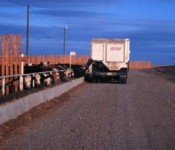Using wheat as an energy source for beef cattle

In a study published in the November 2014 issue of the Journal of Animal Science (“Impact of hard vs. soft wheat and monensin level on rumen acidosis in feedlot heifers”) researchers in Canada conducted a metabolism trial using fistulated beef heifers to determine whether different types of wheat grain could be fed as an alternative energy source.
Dr. WenZhu Yang, a research scientist at the Agriculture and Agri-Food Canada—Lethbridge Research Centre, and colleagues determined whether soft wheat versus hard wheat might ferment at different rates and, therefore, have different values for feeding beef cattle. They also evaluated the effect of feeding more monensin (an ionophore used to improve feed efficiency and prevent or control coccidiosis) than the current practice, Yang indicated.
“The evaluation of these dietary factors was investigated by measuring ruminal pH and rumen fermentation, microbial protein synthesis in the rumen, and the site and extent of nutrient digestion by finishing beef heifers,” Yang said.
The researchers found that wheat can be fed at more than 50 percent of dietary dry matter without adversely impacting the feeding value of the wheat grain, Yang said. Beef producers need to pay attention to grain processing to ensure that ruminal starch digestion is not too fast, Yang said, which could result in subclinical ruminal acidosis or adversely impact animal health and growth performance.
The researchers also found that increasing monensin supplementation decreased feed consumption and increased propionate in the ruminal fermentation pattern, Yang said. Greater monensin feeding suggests a potential for improving feed efficiency.
“However, other factors such as proper feed adaptation, bunk management, and increasing the level of silage in the diet may also be effective management strategies,” Yang said.
Yang said he and his colleagues plan to further their research by determining the optimum processing of wheat grain. They are also developing near-infrared spectroscopy calibrations that will take composition and digestion rate into account.
Media Contact:
Kim Schoonmaker
ASAS Media Communications
kims@asas.org
Scientific Contact:
Larry Reynolds
ASAS Media Communications
Larry.reynolds@ndsu.edu
Media Contact
More Information:
http://takingstock.asas.org/?p=13782All latest news from the category: Agricultural and Forestry Science
Newest articles

First-of-its-kind study uses remote sensing to monitor plastic debris in rivers and lakes
Remote sensing creates a cost-effective solution to monitoring plastic pollution. A first-of-its-kind study from researchers at the University of Minnesota Twin Cities shows how remote sensing can help monitor and…

Laser-based artificial neuron mimics nerve cell functions at lightning speed
With a processing speed a billion times faster than nature, chip-based laser neuron could help advance AI tasks such as pattern recognition and sequence prediction. Researchers have developed a laser-based…

Optimising the processing of plastic waste
Just one look in the yellow bin reveals a colourful jumble of different types of plastic. However, the purer and more uniform plastic waste is, the easier it is to…



